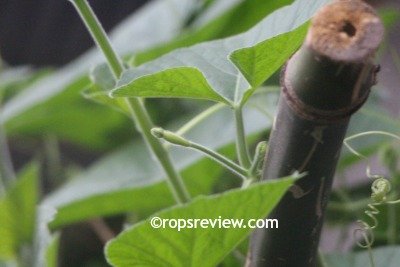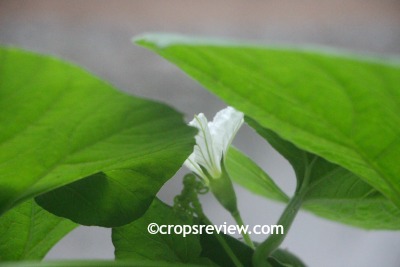Yes, there is plant sex, at least in accordance with the same manner that we perceive sexuality in humans.
Within the same reproductive organ called flower in angiospermous plants, there may be separate tissues that perform functions similar to the sexual organs in humans.
These are the stamen and the pistil.
The stamen is commonly referred to as the flower’s male part while the pistil is the female part.
Such a flower in which both the stamen and the pistil are present is called perfect or bisexual.
Plants bearing perfect flowers only are called hermaphrodytes, such as most cereals, beans, peas, and solanaceous plants.
Otherwise, if the flower has only one reproductive part, it is called imperfect or unisexual.
Unisexual flowers are of two kinds.
The stamen-bearing flowers are called staminate flowers while the pistil-bearing flowers are called pistillate flowers.
These two flower variants are commonly referred to as male and female flowers, respectively.


In-plant species called monoecious, both the staminate and pistillate flowers occur within a single plant.
These may consist of separate individual flowers, as in botlle gourd (Lagenaria siceraria), squash (Cucurbita maxima), and other cucurbits.
In coconut and in many palms, multiple numbers of both flowers occur in the same cluster or inflorescence.
The multiple numbers of flowers may also be borne on separate inflorescences, as in corn (the tassel and the miniature ear).
In dioecious plants, the staminate and pistillate flowers are borne on different individual plants.
Exemplified by the date palm (Phoenix dactylifera), there are male and there are female plants in the same way that there are human males and females.
Date palm exemplifies a phenomenon where plant sex is often meant to refer to the kinds, or genders, of organisms performing distinct reproductive functions.
It is now of common recognition that just like humans and other animals, plants have male and female sexual organs (flower parts) which produce male and female sexual gametes, respectively.
Likewise, X and Y chromosomes are involved in sex determination.
Note: Botanically, according to Randy Moore and co-authors of Botany, International ed., published 2003 by McGraw-Hill, 919 p., reference to male and female flowers and plants is incorrect because no sporophyte or any part of the sporophyte can have a gender.
Accordingly, only the gametophytes can be male or female because they are the direct producers of the male and female gametes.
Author’s query: Technically speaking, is it wrong to refer to humans as either male or female and to their sexual organs as either male or female, respectively?
The credit for discovering the existence of plant sex is generally attributed to Camerarius.
He demonstrated that there are two sexual variants among date palm individuals: the males and the females.
The word “generally” is used here because there is no unanimity as yet.
According to Roberts (1929) and other supporters, Camerarius established the certainty of sex in plants by experimental evidence in 1694.
However, he was not the first to know of it.
These two sentences may appear to be contradictory, but no.
For clarity, let us find enlightenment from the words of this prominent author close to a century ago.
This matter of how sex in plants was established was discussed by Herbert Fuller Roberts of the University of Manitoba (Canada) in his book entitled “Plant Hybridization Before Mendel” published in 1929.
Notes from Roberts (1929)
Accordingly, it was recognized from the very early times of its cultivation, probably in ancient Babylonia and Assyria, that there existed two types of date palm: the sterile and the fruit-bearing.
Likewise, it was known that the product of a “sterile” male tree was needed in order for a fertile “female” tree to bear fruits.
Further, it was found that the pollen from a few trees could fertilize many female trees by hand-pollination.
The word “sterile” here should mean being unable to produce offspring while “fertile” is the reverse, with the same application as in infertile or fertile period for women.
The Arabs continued the practice of manual pollination and seem to have noticed that date palm is divided into two sexes with similar functions to that in humans, particularly in the creation of a new individual.
Many more could have known the existence of plant sex.
Kazwini (circa A.D. 1283), an Arabic writer on natural history, wrote of the date palm:
“It is created out of the same substance as Adam, and is the only tree that is artificially fertilized.”
and also:
“The date has a striking resemblance to man, through the beauty of its erect and slender figure, its division into two distinct sexes, and the property, which is peculiar to it, of being fecundated by a sort of union.”
The early Greeks and the Romans must have also known about plant sex.
Aristotle (384-322 B.C.), Herodotus, Pliny, and Theophrastus (370-287 B.C.) were among those who mentioned it.
However, there was neither suggestion nor investigation to establish the certainty of plant sex and its application to the formation of seeds and to crop improvement.
The artificial pollination of date was only for the purpose of ensuring that individual dates bear more fruits.
Roberts suggested that apart from the date, there was then no other dioecious plant of economic value.
Had there been other more, particularly the annual grain-producing plants, plant breeding could have advanced at a very early age.
Camerarius’s Work
Camerarius did it. He provided experimental evidence for the existence of plant sex.
Camerarius (1665-1721) is the Latinized name of Rudolph Jacob Camerer, then professor of Natural Philosophy at the University of Tübingen in Germany.
On August 25, 1694 (he was 29 years old), he published his memoirs in the form of a letter entitled “ De Sexu Plantarum Epistola.”
It was the first documentation of a scientific investigation on the existence of sex in plants.
For his test plants, he used the Mercurialis, spinach, and hemp which are all dioecious, and corn or maize which is a monoecious plant.
He proved that pollen is essential to fertilization, that the pollen-producing flowers or plants are male, and that the seed-bearing plants are female.
He also discovered that the removal of the pollen-bearing flowers from the staminate inflorescence (tassel) of a corn plant grown in isolation prevented seed formation.
In addition, he contemplated the possibility of outcrossing plants which are now known to belong to different taxonomic classifications.
He particularly mentioned hemp x hops and castor bean x Turkish wheat.
He would not be surprised that the advances in plant breeding have now led to the development of transgenic varieties.
Personal note: The above narration seems to me that plant sex, at least in date palm, had become common knowledge to many a long time ago before Camerarius.
The second quotation from Kazwini in fact clearly stated its existence.
Still, in the world of science, it is not sufficient that the existence of a fact is made known.
The rule now requires that such a fact must be supported with properly obtained experimental evidence and duly published.
The ancients were not privy to these rules.
Anyway, the issue of whether or not Camerarius is the “first” is a trivial matter.
What really matters is that he proved the existence of plant sex in a manner that is acceptable to the end users.
And being so, his investigation could have provided the catapult in plant breeding.
A new thought: Was he credited as well for discovering artificial pollination by means of experimentation?
LITERATURE CITED
ROBERTS HF. 1929. Plant hybridization before Mendel. Princeton: Princeton University Press. Retrieved June 2, 2015, from https://archive.org/details/planthybridizati00robe.
